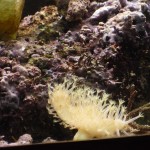Reef Aquarium Lighting: Color Temperature Results
This experiment in reef aquarium lighting was a visual, subjective exercise. Rather than ramble on describing the differences between the combinations, I will let the pictures do the talking. You can enlarge any of the pictures by clicking the thumbnail and viewing the full-sized image page. The intent of this post is to report out on the color temperature experiment conducted using the new line of T5 high output (HO) lamps from ZooMed Laboratories.
Reef lighting is not only a critical life support system for your saltwater reef aquarium, it is also a major contributor to the overall look and feel of your tank. In this experiment, four bulbs, with different color temperatures, were paired together in six combinations to assess the overall impact of the lighting combinations on the appearance of a reef display tank and the corals and fish who reside there.

Compare the results and subtle differences of reef aquarium light combination 1 vs. combination 2: CORAL SUN + ULTRA SUN T5 bulbs vs. FLORA SUN + OCEAN SUN T5 bulbs.
Note that the color on the left is relatively more brown, warm, and natural than the slight bluish/purple tinge of the combination on the right-hand side.
In these nearly identical pictures of a Colt coral (Capnella sp.), one can see the impact, although subtle, of color temperature on the appearance of the tank and its inhabitants.
Both combinations are noticeably bright–not surprisingly because the ULTRA SUN and OCEAN SUN lamps were in opposite pairs. I would characterize the overall color temperature of pairs 1 and 2 to be mostly white. There is only a subtle detectable difference attributed to the brown/red glow from the FLORA SUN (left)vs. the blue glow of the CORAL SUN (right).

Compare the results and subtle differences of reef aquarium lighting combination 3 vs. combination 4: CORAL SUN +OCEAN SUN T5 bulbs vs. FLORA SUN + ULTRA SUN T5 bulbs.
In this comparison, the puple and pink colors really pop on the left-hand side, in the clownfish as well as in the colt coral–and the purple colors of the coralline algae on the live rock amost glows. The lighting on the right-hand side has a bright white appearance–making the colt coral appear tan, the white tile next to it looks white and the clownfish actually have a natual looking color.
As you can see from the images–seemingly minor changes in light bulb color temperature can have an impact on the appearance of your tank. To keep the arms of the experiment to manageable set, I only rotated the lamps in combinations of one bulb for each temperature–but the impact of a particular bulb style on the appearance can be further amplified or fine tuned with a variation of the number of bulbs from a given color temperature range. A finer level of precision could be achieved to create the optimal color combination for your individual reef needs.
More conclusions, takeaways and advice to come in the next post.





Leave a Reply